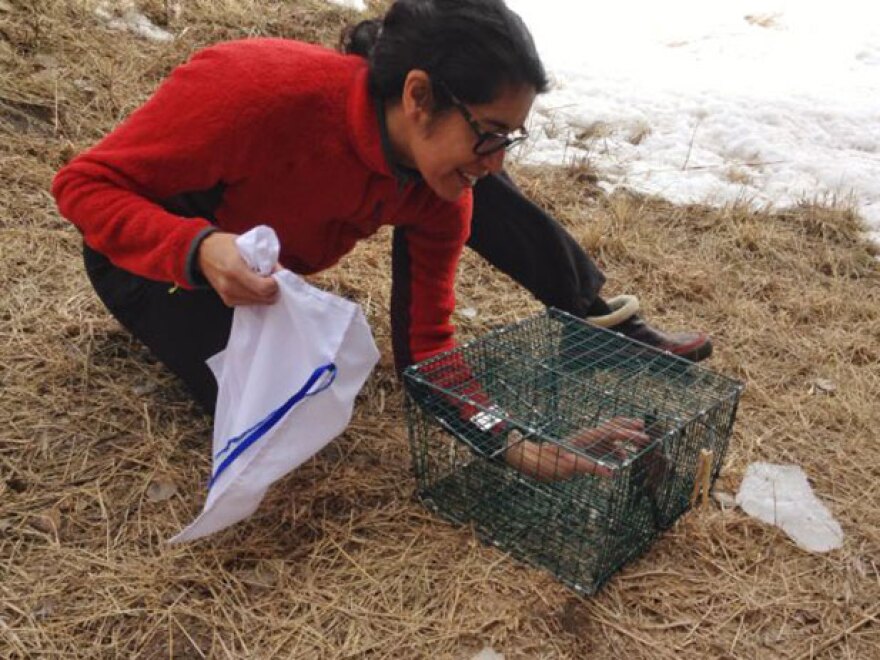The Brown-capped Rosy-Finch is a small passerine bird of the Rocky Mountain West known for its dusky pink plumage. But don’t let the delicate hue fool you: Rosy-finches are hardy creatures that live in the highest altitude of all finches in North America, favoring wind-whipped alpine cliff faces for nests and spending much of their lives among snowfields and high peaks.
Because they prefer isolated alpine habitats, rosy-finches are feared to be particularly vulnerable to climate change – and breeding populations are already believed to be declining in places like New Mexico. But there’s a lot that scientists still don’t know or understand about the diminutive birds.
A new long-term and broad-reaching research project aims to change that. Colorado Parks and Wildlife, the Bird Conservancy of the Rockies and the University of California Santa Cruz have teamed up to conduct a multi-year study on the Brown-Capped Rosy Finches. The study will also include the two other rosy-finch subspecies: The Black rosy finch and the Grey-crowned rosy finch. The study entails bird counts, observing finches in their summer habitats and wintertime banding in locations across the state.
Quote: These are little walk-in traps. So we put seed in the back and there’s a little trigger …
That’s Erika Zavaleta, an ecologist and professor from the University of California Santa Cruz who is a lead researcher on the project. Zavaleta and two research assistants are working at a banding station at a home near Mountain Village on a recent grey morning. Some ten birds have wandered into the wire cage traps in the 20 minutes since they have last been checked, and Zavaleta carefully fishes them out, placing each in a cotton bag.
Quote: And these are all Brown-capped Rosy Finches that I’m sure you hear, which are the ones that both winter and breed ….
Brown-capped Rosy-finches spend much of the year above 10,000 feet, but migrate down to mountain towns in the winter to feed, which is how many ended up at this Mountain Village feeder. The birds travel in flocks, and on this day, it’s a bonanza as they furiously peck at the birdseed.

Sound … birds on feeder
More than 100 birds gather on window panes, nearby trees, and on the platform feeder to scarf the sunflower seeds. As they eat, many walk into the cages and became research specimens for the team.
Once the birds are bagged, they’re brought to a table, where volunteer Laura Antonello and incoming PhD student Tim Brown measure and record their weight, sex, body fat and approximate age before affixing one spindly leg with a tiny blue metal band and letting them go.

The project was launched in the spring of 2017 and will continue for at least five years. CPW spokesperson Joe Lewandowski says it aims to fill in gaps in understanding of the birds.
Quote: You know, how are these birds doing … we don’t really know a lot about them…
The entire study area encompasses both winter banding sites in places like Evergreen and Estes Park as well as summer field studies in higher sites in Colorado and the Sierra Nevada Mountains of California.
The idea is to gather the data into a database and analyze patterns, trends and habits of the rosy-finch. Scientists will look at factors like how far they travel, how their young survive, insect food in the high-country, summer rainfall and snowpack, and will be examining the effects of climate change closely.
Quote: That’s one of the things I wanted to look at…
The team has banded about 700 birds so far this year; the goal is 1,000. And citizen birdwatchers can help.
Quote: If birders are out there and they spot one of these birds…
Zavaleta stresses that in this project, the importance of citizen science can’t be understated.
Quote: it’s be great for people to know that if they see banded Rosys, that’s like solid gold …
Birders can report sightings to rosyfinchreports@gmail.com. Rosy is spelled R-O-S-Y. Birders are asked to specify locations, species of Rosy-Finch, number of birds and band color, if any.


